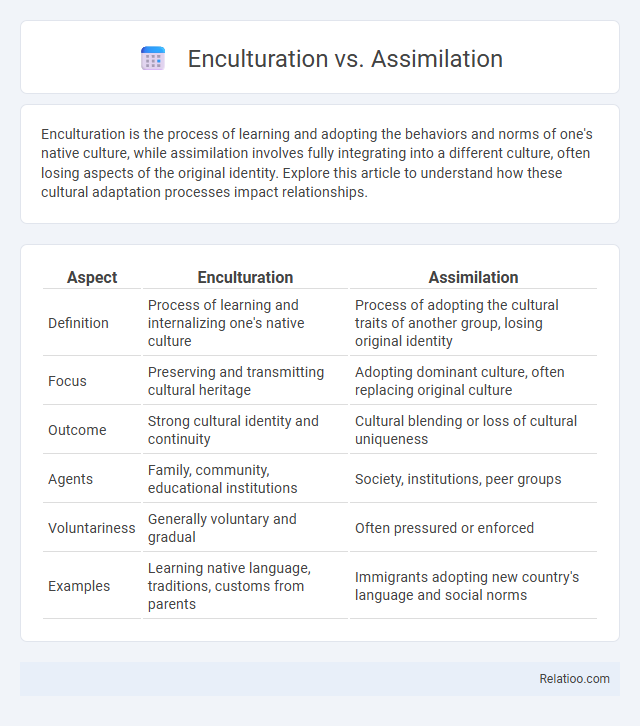Enculturation is the process of learning and adopting the behaviors and norms of one's native culture, while assimilation involves fully integrating into a different culture, often losing aspects of the original identity. Explore this article to understand how these cultural adaptation processes impact relationships.
Table of Comparison
| Aspect | Enculturation | Assimilation |
|---|---|---|
| Definition | Process of learning and internalizing one's native culture | Process of adopting the cultural traits of another group, losing original identity |
| Focus | Preserving and transmitting cultural heritage | Adopting dominant culture, often replacing original culture |
| Outcome | Strong cultural identity and continuity | Cultural blending or loss of cultural uniqueness |
| Agents | Family, community, educational institutions | Society, institutions, peer groups |
| Voluntariness | Generally voluntary and gradual | Often pressured or enforced |
| Examples | Learning native language, traditions, customs from parents | Immigrants adopting new country's language and social norms |
Introduction to Enculturation and Assimilation
Enculturation is the process by which individuals learn and adopt the cultural norms, values, behaviors, and social skills necessary to function effectively within their own society, typically occurring through family, education, and community interactions. Assimilation involves the absorption and integration of individuals or groups into a dominant culture, often leading to the loss or alteration of original cultural identities and practices. Both concepts highlight different mechanisms of cultural adaptation, where enculturation emphasizes cultural continuity, while assimilation focuses on cultural change and blending.
Defining Enculturation: Core Concepts
Enculturation is the process through which individuals learn and internalize the cultural norms, values, behaviors, and social practices of their own society, shaping their identity and worldview. This lifelong developmental process occurs primarily through family, education, language acquisition, and social interactions, enabling individuals to function effectively within their cultural context. Understanding enculturation highlights how cultural knowledge is transmitted across generations, distinguishing it from assimilation, which involves adopting the traits of another culture, often at the expense of one's original cultural identity.
Understanding Assimilation: Key Features
Assimilation involves the process where individuals or groups absorb and integrate into a different dominant culture, often resulting in the loss of original cultural traits. Key features of assimilation include adopting the language, customs, and social norms of the host culture while minimizing distinct cultural identities. Understanding assimilation helps you recognize the challenges faced when balancing cultural preservation with societal integration efforts.
Differences Between Enculturation and Assimilation
Enculturation is the process by which individuals learn and internalize their native culture's values, norms, and behaviors, maintaining cultural identity within their original social group. Assimilation involves the absorption and integration of an individual into a different cultural group, often resulting in the loss or diminishment of the original cultural identity. Understanding these differences helps you navigate cultural adaptation, preserving your heritage through enculturation or embracing new cultural norms via assimilation.
The Role of Enculturation in Identity Formation
Enculturation plays a crucial role in identity formation by embedding cultural values, beliefs, and practices into an individual's worldview from a young age, shaping how You perceive yourself and relate to others. Unlike assimilation, which often involves adopting a dominant culture and losing original cultural traits, enculturation preserves cultural heritage and reinforces a strong sense of belonging and self-identity. Understanding enculturation helps highlight how cultural continuity influences personal and social identity development across generations.
Assimilation and Cultural Change
Assimilation involves the process where individuals or groups adopt the dominant culture's traits, often leading to significant cultural change by diminishing their original cultural identity. This contrasts with enculturation, which is the lifelong process of learning and internalizing one's native culture. Your understanding of cultural dynamics deepens when recognizing how assimilation can accelerate cultural change by blending or replacing traditional customs with new societal norms.
Influencing Factors: Family, Education, and Society
Family plays a crucial role in enculturation by transmitting cultural values, language, and traditions directly to you from an early age. Education systems influence assimilation by imposing dominant societal norms, language, and behaviors, often encouraging adaptation to mainstream culture. Society at large affects both processes through social expectations, media, and peer interactions, shaping how individuals adopt or maintain cultural identities.
Case Studies: Enculturation vs Assimilation in Practice
Case studies in cultural integration reveal enculturation as the process where individuals learn their native culture passively, often within family units, preserving linguistic and social norms over generations. Assimilation involves a more active, sometimes forced, adaptation to a dominant culture, exemplified by immigrant communities adopting mainstream language and behaviors to gain social acceptance. Comparative research highlights that successful cultural retention often depends on community support systems that facilitate enculturation, while assimilation may lead to identity loss and social tension when imposed without sensitivity to original cultural values.
Effects on Individuals and Communities
Enculturation strengthens Your cultural identity by transmitting values and traditions within a community, fostering a strong sense of belonging and continuity. Assimilation often leads to the loss of original cultural traits, creating challenges for individuals as they adapt to dominant societal norms, sometimes causing identity conflicts. Integration balances cultural preservation with adaptation, enabling individuals to participate fully in multiple cultures while enriching both their community and personal development.
Conclusion: Navigating Cultural Integration
Navigating cultural integration requires understanding the distinct processes of enculturation, assimilation, and acculturation, each shaping your identity differently. Enculturation involves internalizing your native culture, assimilation demands adopting the dominant culture often at the cost of your original identity, while acculturation balances maintaining cultural heritage with embracing new cultural elements. Successful integration fosters respect for your cultural background while adapting to social environments, enhancing personal growth and social cohesion.

Infographic: Enculturation vs Assimilation
 relatioo.com
relatioo.com